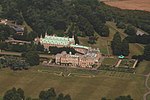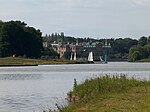St Winifred's Church, Holbeck
Church of England church buildings in NottinghamshireChurches completed in 1916Grade II listed churches in Nottinghamshire

St Winifred's Chapel, Holbeck is a Grade II listed parish church and former private chapel in the Church of England in Holbeck, Nottinghamshire, south-west of Worksop. Holbeck is an estate village built for the Dukes of Portland at Welbeck Abbey.
Excerpt from the Wikipedia article St Winifred's Church, Holbeck (License: CC BY-SA 3.0, Authors, Images).St Winifred's Church, Holbeck
Holbeck Lane, Bassetlaw Norton, Cuckney, Holbeck and Welbeck
Geographical coordinates (GPS) Address Nearby Places Show on map
Geographical coordinates (GPS)
| Latitude | Longitude |
|---|---|
| N 53.253275 ° | E -1.1821944444444 ° |
Address
Holbeck Lane
S80 3NG Bassetlaw, Norton, Cuckney, Holbeck and Welbeck
England, United Kingdom
Open on Google Maps








